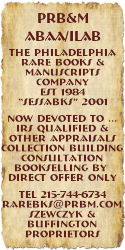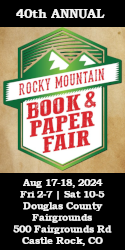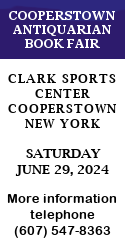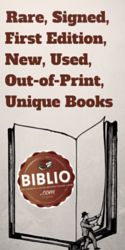Homage to Charlie Everitt
As we have established the book business is always at heart a “Treasure Hunt”. It's axiomatic that experience will bring success if paired with hard work and a little luck. Remarkably the luck factor tends to increase in direct proportion to the amount of hard work spent, but that's another story. At the annual week-long Colorado Antiquarian Books Seminar (CABS), held each Summer in Colorado Springs, the faculty, all dedicated antiquarian booksellers themselves, advise students to “Look At The Book”! That mantra is repeated ad infinitum throughout the week, yet it is the essential kernel from which all evaluation proceeds. Great advice even for those of us who have been engaged in this business for years. Careful examination of the book speaks volumes, (sorry), in identifying the specifics of the item. Edition, age, in some cases scarcity, provenance, printer, binding designer, watermarks, limitation, importance and value can be largely determined by that initial observation…but sometimes pieces just speak to you.
Often there is just something about an obscure book or piece of ephemera that gnaws at you. It demands more attention and I find myself setting them aside for further review. Recently as I was working through a box of miscellaneous old paper, largely publishing house advertisements for forthcoming books all from the 1890s to the 1920s I saw a small bifolium – a bifolium is a sheet of paper or parchment with writing or printing on the recto and verso of a folded sheet, creating four leaves or pages. There was no indication of author, or publishing source or date. It was simply the rules for a game called “Word-Link” that could be played by two people or more and all one needed was a pencil and a piece of paper. The rules were simple but clever and one had to be aware of the flow of the game to control and win the round. It was intriguing. What to do with it? I could tell by looking at the paper that it was a late 19th century piece. It was a game and better yet a word game, so there would be interest in it because of those facts alone, but who, where and how did it come to be?
There are many research tools available to the antiquarian bookseller. Most of us have acquired over the years libraries of reference books, bibliographies, pamphlets, and monographs on authors, printers, presses etc., and while most of us own a set of the ‘BAL’, (Bibliography of American Literature) in nine volumes, Howes’ U.S. iana, & Ahearn’s Collected Books, we diverge into our specific interests and specialties. I always have a need for Brun’s Angling Books of the Americas, Heitman’s Historical Register of the United States Army and Wheelock’s Bibliography of Theodore Roosevelt –tools that are essential for my approach to this business. In years past every January we would all purchase an must-have resource, it was always an octavo, averaging 1000 pages bound in red cloth with gilt lettering, American Book Prices Current, the auction records. A yearly report of ALL the books and manuscripts sold at the major reporting auction houses – Swann Galleries, Pacific Book Auctions, Waverly, Sotheby’s, New England Book Auctions and others. What had been trending? What obscurities had surfaced and what major collections had gone under the hammer? It was exciting, revealing and essential. ABPC is still a major resource but not unlike other sea changes in this business, it is no longer published as a book. It's still proprietary information, by subscription, but is on-line only and there are advantages to that. I no longer have to use ten volumes to see what the decade long trend on an item or author has been, it is presented complete on screen, and may reveal a twenty year track record.
But what about “Word-Link”? Through my research I was able to discover that this was in fact the first incarnation of a game later referred to as “Doublets”, it was printed in Oxford England at the Oxford University Press in 1878 and was invented by a C. L. Dodgson. That name should ring a bell. He wrote under the pseudonym, Lewis Carroll, the author of “Alice in Wonderland” and “Through The Looking Glass”. Further research revealed that there were only five known copies in libraries, among which were Harvard, NYU & the Morgan – curiously there were no holdings in British institutional libraries. There was one other copy though, from the Faletta Collection, that sold at a Christie’s sale in London in November of 2005. It fetched £1,600, the equivalent of $2,776 (at the time). Because it was Lewis Carroll, because it was very scarce, because it was ephemeral, because it was unlikely that one would surface in the immediate future, the Faletta copy commanded the attention of the Carroll Collecting World and performed quite well. This allowed us to offer our copy to a collector within that price range and at the same time to deliver a truly scarce gem that distinguished the collection that received it. That is the win/win for the dealer and the collector. After all it is always a “Treasure Hunt”!
--

























